Exploring the Steam wishlists/sales ratio
4/29/2024
GameDiscover.co recently published results of their wishlist conversion survey. Intrigued by that data, we thought it would be interesting to dive deeper into the Steam wishlists/sales ratio. In this article we will explore how various factors, like price, Early Access, and review scores affect how wishlists translate into sales.
Before getting into the data, let's first explain the methodology. We used our custom sales and wishlist estimation algorithms to estimate conversion ratios. Our sales estimation algorithm is within 30% error margin in 77% of cases (our wishlist estimation algorithm has similar accuracy) and should give us fairly good results for aggregate data. We sampled around 700 games released after September 2023 with at least 5000 wishlists and at least 500 copies sold within the first month. Also note that we are testing total wishlists/sales ratio here, not just direct wishlist to sale conversions
Alright, without further ado, let's jump right in!
Distribution
Let's first take a look at general distribution. We have median month 1 sales as 27% of launch wishlists and median week 1 sales at 22% (23% and 17% respectively if we don't additionally filter out games that sold <500 copies within m1, but we'll filter them from now on so small games don't skew the data). This aligns with GameDiscover data btw, where they had w1 at around 20%

Top 10% of games have m1 sales as 134% of their launch wishlists, while bottom 10% have m1 sales as 6% of launch wishlists
1. Early Access
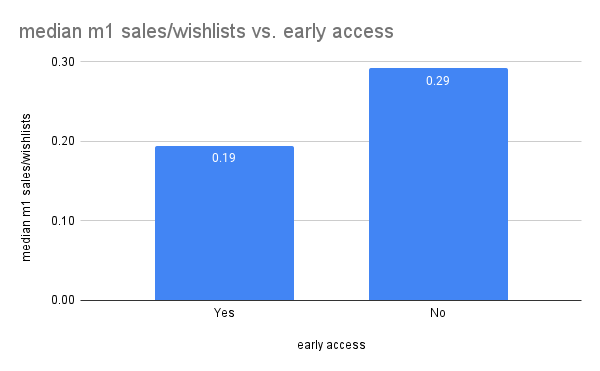
As you might expect, Early Access games convert worse than their full release counterparts. Early Access games have median m1 sales as around 20% of their launch wishlists, while full release games have their median at around 30% of their launch wishlists.
2. Price
It comes as no surprise that more expensive games convert less wishlists. However, it also seems like games priced over $20 translate wishlists a little better the more expansive they are. This is probably because the more expensive games are of higher quality and more popular in general
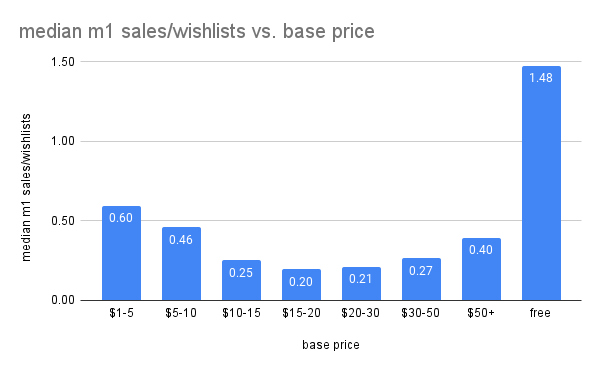
But let's look at this another way: Instead of looking how wishlists translate to sales, let's take a look how much revenue games made per wishlist:
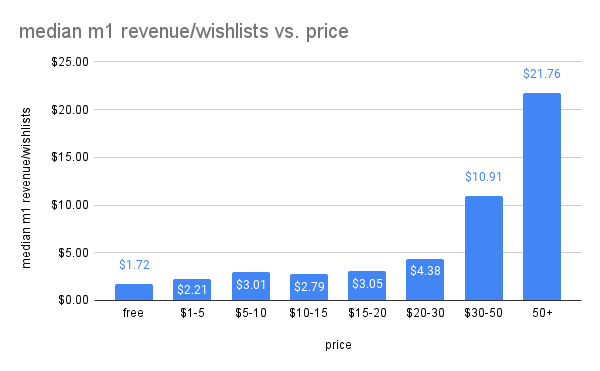
Now the tables have turned. More expansive games convert wishlists into more $
3. Launch Discount
Now, the most interesting part! How does the launch discount affect m1 sales relative to wishlists?

Surprisingly, we don't see much change there. It even looks like games with launch discount convert slightly worse than games without it? What's going on there? We think it is a combination of the following:
- Player interest: Firstly, when you release your game, people who are interested in it would buy it no matter if it's full price or 50% off. The price isn't the main factor for them; it's about getting to play the game they've been waiting for.
- New price norm: When you launch with a discount, it creates a new expected price norm for your game. Players might then expect further discounts in the near future, which again could discourage them from buying at initial price like you had no discount at all. Moreover, players who might discover your game after the initial discount period might be deterred from purchasing it, feeling they missed out on a better deal and waiting for another discount. This could in turn hinder your game's organic growth
- 10-15% off does not change much: The usual launch discounts, like 10-15%, aren't a big deal. Most people take their time before buying, and impulse purchases don't really work there.
- Niche publishers: This data might be a bit skewed because maybe some niche publishers don't do launch discounts and have high wishlist conversions.
Now, let's make one thing clear: We are not saying that you shouldn't do launch discounts. However, they are certainly not mandatory for a successful launch and we think that they might be a bit overused by developers. Valve themselves recommend launch discount around 10-15%, IF you chose to have one
4. Review Score
As you might expect, higher-rated games do tend to convert more wishlists into sales
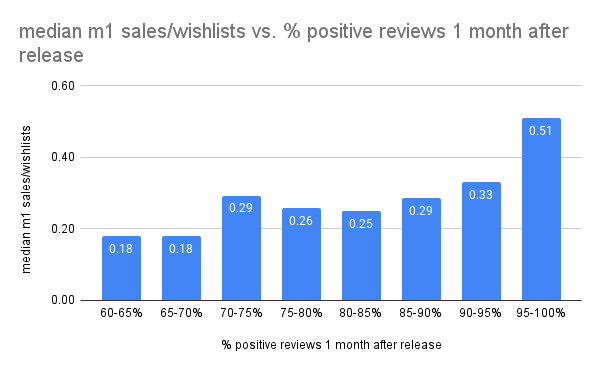
5. Popularity
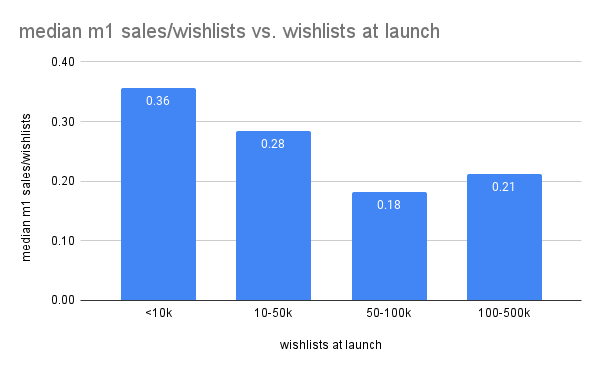
Interestingly, games with a higher number of wishlists before release tend to have lower conversion rates. But this is because more popular games are usually more expansive, and we know that higher-priced games generally convert fewer wishlists into sales.
6. Tags
Let's try one more thing. Let's see if Steam tags correlate with how wishlists translate to sales.

however, we think this is more a reflection of price differences and other factors than tags directly affecting conversions. In any case, the data looks interesting!
Conclusion
I hope you enjoyed the article! The numbers shared here might provide some guidance for your game releases. But remember, the wishlist-to-sale ratio is unpredictable and influenced by many factors we haven't covered here. Predicting game sales is tough. Some games unexpectedly go viral, while others don't meet expectations.
If you found this article interesting, check out our tool at gamalytic.com
We are not affiliated with Valve or Steam in any way